I have addressed how the Fed is walking on a tight rope and I have made the direct correlation between a falling dollar and a rising S&P 500 (as the dollar falls the value of all goods expressed in dollar terms rises). Now I think it is time to do a little thought exercise and see what we think might happen if we keep following a certain path.
The fed can print as much money as they want. If the printing presses are at full speed, then the value of each outstanding dollar declines. This is a simple fact, just think of it this way – when there are 2 dollar bills chasing a specific $1 good, then the value of the good will increase and require $2 instead of the original $1. So every dollar that you hold has been halved in value. This is considered the money supply. The only reason that we are not currently seeing a dramatic bout of inflation is because individuals and companies are not spending money, so the velocity of money has slowed enough to offset the supply of money. Put simply, as soon as those extra dollars that were printed start hitting the streets, there will be dramatic inflation, but that can only happen when people and businesses start spending money…that will happen when the fed prints enough money to give to the banks so that they feel comfortable lending back to the consumer – then the cycle begins again.
Here is the issue that I want to address today: so what? A lot of economists will state that we need inflation and we need the fed to print a lot of money so that the economy does not 1) collapse or 2) end up in a spiral of deflation just like Japan.
Here is the problem with that argument – if the dollar is devalued enough, the Chinese and other Asian countries are going to become even more upset than they already are because they hold a ton of US debt in US Dollars. A falling dollar means that all of their debt declines in relative value. I would be upset as well and would not blame them for stepping away from the US Federal Reserve Ponzi scheme. What this implies is that a falling dollar stops the marginal Asian treasury buyer. Put simply, they would stop subsidizing our debt as heavily as they currently are. Any marginal drop in their debt purchase would drive up interest rates. The fed would be powerless.
So we end up in a rather ominous situation:
- Falling dollar (cost of all foreign goods rise dramatically – farewell cheap Walmart goods)
- Continued high unemployment
- High interest rates for a debt loaded consumer and stumbling housing market
The only positive out of high inflation is that we devalue our current debts (pay back $100,000 owed with the equivalent of $60,000 in real terms) and goods produced in America become cheaper to foreign buyers. The flip side is that it also makes it much cheaper for foreign investors to buy American companies, real estate, and people.
Way to sell America on the cheap. Bravo.



